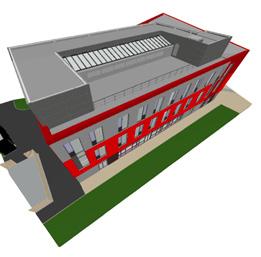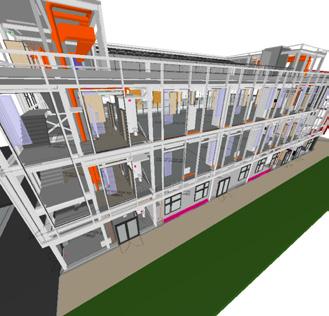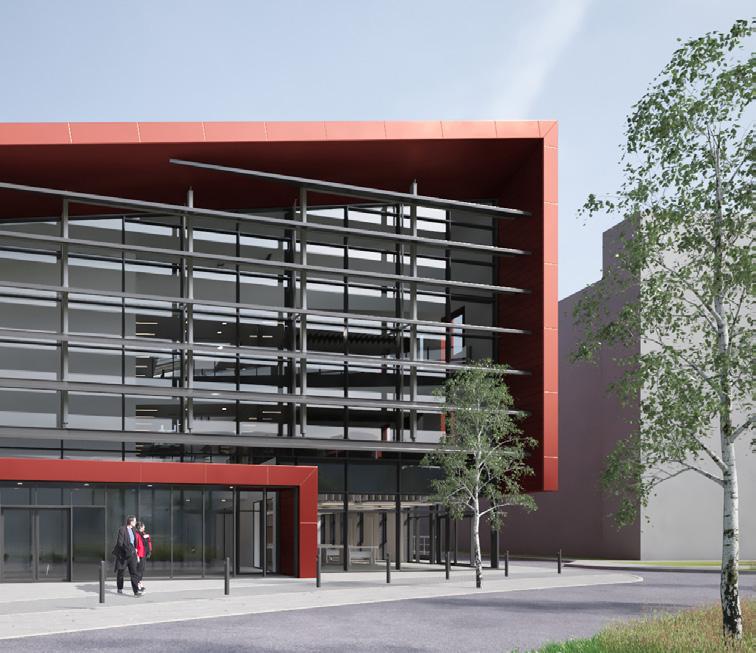
7 minute read
Aligned processes produce better data
A L I G N E D P RO C ES S ES PRODUCE BETTER DATA
As information managers on the WMG Degree Apprenticeship Centre project, Bond Bryan Digital started their task from aligning the detailed requirements set in the project and continued with not only applying but also improving the model checking processes, ensuring a robust model delivery to the client.
Advertisement
A part of the Bond Bryan architectural company, Bond Bryan Digital (BBD) is an award-winning consultancy offering expertise especially in information definition and management throughout building projects. One of Bond Bryan’s latest projects is the WMG Degree Apprenticeship Centre for the University of Warwick in central England, UK, where initially the Bond Bryan architectural team was appointed as architects on the project. The main contractor, Kier, later brought in also Bond Bryan Digital to work as information managers. BBD Associate Director Rob Jackson describes: “Our general approach on all our projects is to align with open standards and OpenBIM processes. This is because we use a variety of software, so building the infor mation requirements around open standards allows us to build a robust process.” Following standards also allows re-using what has been done before. Jackson continues: “We re-use a lot of our work that we have created on other projects, so we never start a new project from scratch. We have a library of rules based on open standards, for example, aligned around COBie and layering standards. Then, in addition to those, we configure client or project specific rulesets when needed.”
BBD also puts in effort to help the authors deliver their work in the set requirements, which was an especially natural part of the Apprenticeship Centre project as the architectural team was from Bond Bryan, as well. “We could just let the authors deliver, check the models and then say they’re not suitable for our use,” Jackson smiles, “but we like to try and support them as much as possible to deliver those models efficiently and effectively.” For this, BBD provides training and creates mapping files for the authoring tools to make it clear what and how needs to be delivered. “So, it’s really a process of engaging the authors in the delivery. So far, it’s gone really well, and we’ve proved that we can deliver in alignment with open standards.”
Another interesting characteristic of the Apprenticeship Centre project is that the assignment included not only designing and checking the building model but also the landscape model. “It has some interesting features where we have to also look at the modeling aspects and change some of those to deliver the information requirements for the university,” Jackson remarks.
The university also requires the delivery of a native Autodesk Revit model, and as the Bond Bryan architectural team uses Graphisoft ARCHICAD as the delivery tool, BBD took on an additional challenge to transfer the models between ARCHICAD and Revit. “As a digital team, we have a passion for the ability to exchange our models without necessarily having to use a specific tool. We carried out a lot of research on how a model transfers between the two tools to transfer not only the geometry but also the data in a suitable format. And obviously, Solibri plays an important part in that process in assuring that both the geometry and data are robust throughout the transfer,”
Jackson mentions. The effort paying off, BBD can already transfer files with minor manual fixing required and continues to work towards a fully automated transfer.
In all projects, BBD applies the model checking process both by stage and by discipline. On the Apprenticeship Centre project, there are 5 different models; the architectural, mechanical and plumbing as one model, electrical, landscaping and the structural model. “We go through a checking process aligned with the IFC tree, that is, project, site and building; floors, spaces and zones, and types, components and systems. This creates a workflow through the tree,” Jackson describes.


MODEL VIEW
The federated model and model checking examples on the Apprenticeship Centre project in Solibri.

What follows is checking the attributes, which goes far deeper into the details. “It’s not only about identifying the issues, though,” Jackson points out, “but equally, we try to give the authors enough information about how to fix the issues, as well. For example, if all the doors don’t have door numbers, there’s no point in listing out every door without a number. Instead, we would simply list out the fact that all the doors are missing the door number and need to be reviewed. In other instances, then, say if one door has a duplicate number, we would obviously list out the specifics of that door.”
In the Apprenticeship Centre project, BBD has been reporting the found issues regularly, asking the authors to clean up as much of the issues found in the data side of the models as possible during each round. “We don’t expect the next iteration to be perfect, but we hope for progression and try ensure that the models are consistently moving towards the end goal,” says Jackson. As the project has progressed, also the checking gets easier as the models are now down to only a couple of fundamental issues to solve. BBD shares the federated Solibri model file with all the model checking rules run in the file, in the common data environment of the project, making it easy for anyone in the project to view the models in the free viewer version of Solibri.
BBD also uses the Solibri information takeoff for checking the correctness of the data in certain simple schedules. Jackson explains: “You can quite quickly see what the quality of the model is like in information takeoff. For example, if all the descriptions are missing, you can quickly go down them in an information takeoff.” The information takeoff, linked with the model, also provides a quick visual way to identify the issues. In addition, the information takeoffs are linked to COBie spreasheets generated in Solibri according to the British

regulation, as well as data classification within the federated model. This creates a very efficient process no matter what location the data is saved in in the original models.
“Quality assurance is something we’ve done for a number of years. It’s always continued improvement and for us, Solibri plays a huge part in the process,” Jackson continues and emphasizes the importance of the open standards work also in terms of continuous learning. “It’s matured a lot as we’ve gone forward and the more work, we’ve done around quality assurance, the more work we’ve done that open standards are critical to that process. For those reasons, buying any technology isn’t the answer, even if it’s an important part of it. Implementing quality processes takes learning and commitment and looking at it as an overall project.”
The benefits seen from the model checking work around open standards are clear. “In terms of quality, we have seen better outputs, better quality of delivery, and contractors repeatedly come back to Bond Bryan for quality and delivery of our work, both design and technical delivery, so we have developed a very sound reputation based on that,” Jackson concludes.
HANNA BACKMAN
ROB JACKSON
Rob Jackson is an accomplished information manager and BIM consultant with vast experience in construction and a background in architecture. An advocate of OpenBIM workflows and the use of open standards for years, he actively takes part in various BIM committees and platforms, presents at BIM related events worldwide, and engages in conversation both in social media and in the BIMBlog by Bond Bryan Digital.
MODEL TO
STANDARD
SOLIBRI QUALITY APPROVED
MODEL TO T H E STANDARD
More than just a number
7 out of the top 10 Dutch construction companies use Solibri 7 out of 10 top Nordic construction companies use Solibri 7 out of 10 top Finnish construction companies use Solibri A billion global model components checked with Solibri every month 100 % increase in users year on year










